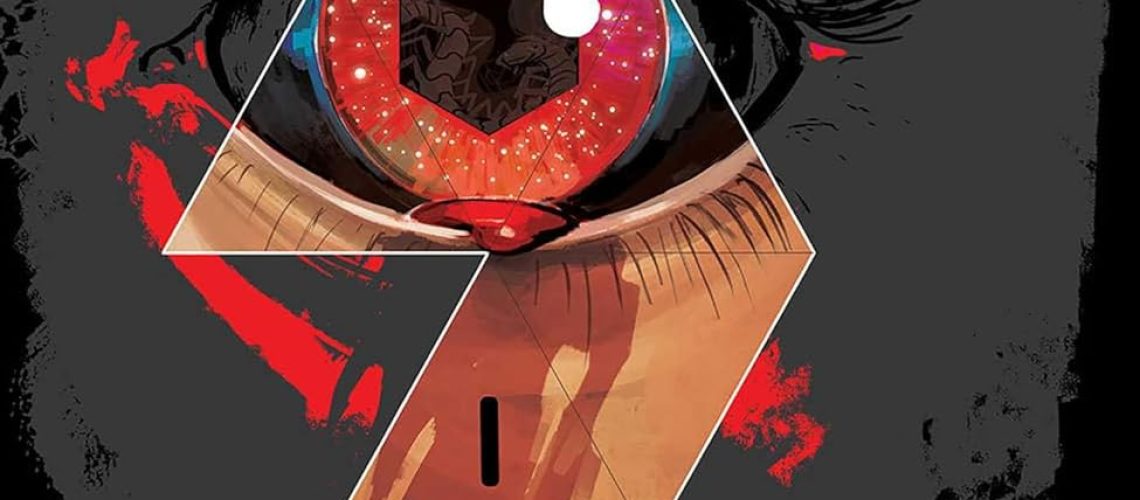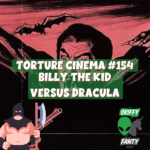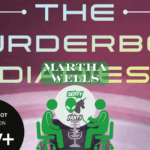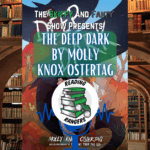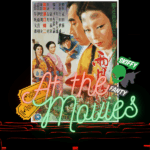I think we’re probably all familiar with the idea that across media, there were a bunch of exciting new releases, deserving of more attention, that just kind of vanished into the pandemic. It was especially true of movies, of course – how many new films got an unfair reputation for having “underperformed at the box office” for the crime of having come out when no one was going to the cinema?
But it’s not only true of movies. Although graphic novels and books sold well overall during the pandemic, with comic shops and book stores closed, discoverability and conversations around new books took a hit. Some amazing work was released without the fanfare it deserved. One of those was a remarkable 20-issue dark portal fantasy, since collected in four volumes. It asked what would happen if a group of teenagers was transported to the world of their table-top roleplaying game – and what would happened if, twenty-five years later, as traumatized, broken adults, they had to go back.
Let’s take a look at DIE.
“In the nineties, six teenagers disappeared into a fantasy role-playing game. Only five returned. Nearly thirty years later, these broken adults are dragged back to discover the game isn’t finished with them yet…”
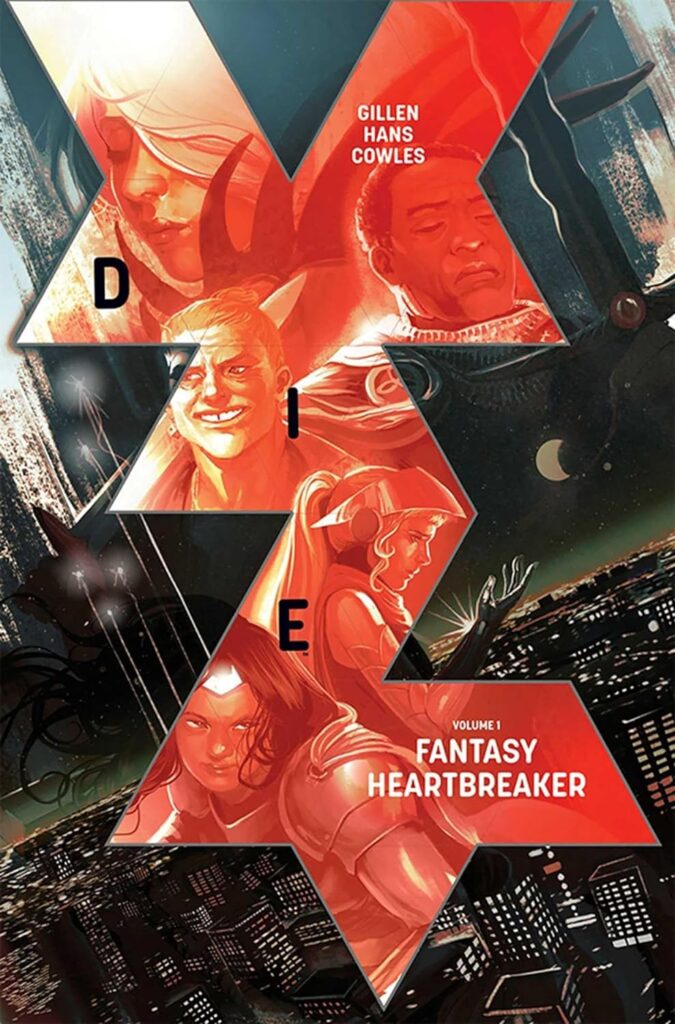
DIE
Writer: Kieron Gillen
Artist: Stephanie Hans
Letterer: Clayton Cowles
Designer: Ryan Hughes
Editor: Chrissy Williams
Published by Image Comics
Volume 1: Fantasy Heartbreaker
In 1991, it’s awkward, reserved teen Ash’s birthday. With his younger sister Angela in tow, they visit Ash’s best friend Sol, who promises Ash an unforgettable TTRPG experience to celebrate the occasion. Joining them are feckless, exuberant Chuck; kind, steadfast, but grieving and deeply depressed Matt; and Sol’s sometimes-girlfriend, clever, slightly mean Izzy, who seems to consider herself a bit above gaming with the others, even though she never misses a session.
Sol presents his friends with a bespoke role-playing game, and when they describe the characters they want to play, devises unique character classes and gives them a specific die that – in his game – they and only they get to use.
Ash plays the Dictator, who can control others with their words, and is given a D4.
Matt is a Grief Knight, who channels emotions into combat, and uses a D8.
Angela is a Neo, a cyberpunk rogue, with a D10.
Izzy, the Godbinder, bargains with the divine and bears a D12.
Chuck, who really didn’t put a lot of thought into all of this and just wants to wave a sword and cause chaos, becomes the Fool, with the most common die of all, a D6.
Sol is the Master, a sort-of-DM who’s also a character, and uses a D20.
And when they roll their dice for the first time, the six teens disappear.
They don’t reappear for two years. Angela is missing an arm. Sol never comes back. And none of them can speak about what happened to them.
Twenty-five years after that…
Ash is married, trying to get through life with his head down. It’s his birthday, a day he never celebrates. But then a mysterious package arrives for him. A box, containing a set of polyhedral dice. Ash knows that it’s a call, a message from Sol. And for the first time in twenty-five years, he brings together the others.
Angela has a failed married and an unrewarding career. Matt has a loving family and stability but is still in the shadow of grief and depression. Izzy – Isabelle – is mired in a mediocre life, her creative sparks long-dead. All of them still bear the scars. Except Chuck, who seems barely affected, and has become a successful fantasy novelist and movie producer.
They all – even Chuck – have their own reasons for picking up their accursed dice, but they all do, and in a blink they return to the world of Die.
Die is an icosahedral world – 20-sided – each side a distinct setting, governed by a Master who exemplifies the nature of the realm. Ruling over them all is the Grandmaster, who the Party had to find and defeat to escape Die the first time.
In Die, Ash is a woman, beautiful and confident, using her Dictator powers to control others. She releases them from the geas that she placed them all under years before to prevent them from talking about their experiences.
The others take back on the capabilities of their characters as well. They’re confronted by Sol, who announces that he’s defeated and become the Grandmaster, which means that he’s the one who brought them there, and that he’ll be able to literally rewrite the rules to suit himself as they try to get home.
After a short battle against the Fallen – Die’s zombie-like horde of enemies for characters to fight – they’re presented with a classic Fetch Quest, with some obvious exposition instructing them to collect magical keys from dungeons foul and yadda yadda to reach the realm of One, where the Grandmaster resides.
They all immediately recognize that Sol is as much of a railroader as ever. The problem is, they need him; everyone in the Party has to agree to return home. Ash suggests that they take his campaign off the rails by destroying some of his favorite set pieces, so they set out across Die to find and destroy the previously safe haven of Glass Town.
They succeed, both in destroying the city and drawing Sol out. In the fighting, Ash kills Sol, which should make it possible for them to leave Die without him. But Isabelle feels responsible for Glass Town’s refugees and refuses to abandon them, and Chuck doesn’t want to leave at all. They teleport away, leaving the others in the ruins of Glass Town. Along with Sol, who rises as a Fallen, revealing that he – and all the Fallen – are people from our world who were drawn into Die, and died.
(Whew, that was a lot, but I felt like a certain amount of context was necessary. Volumes 2 through 4 will be summarized more briefly!)
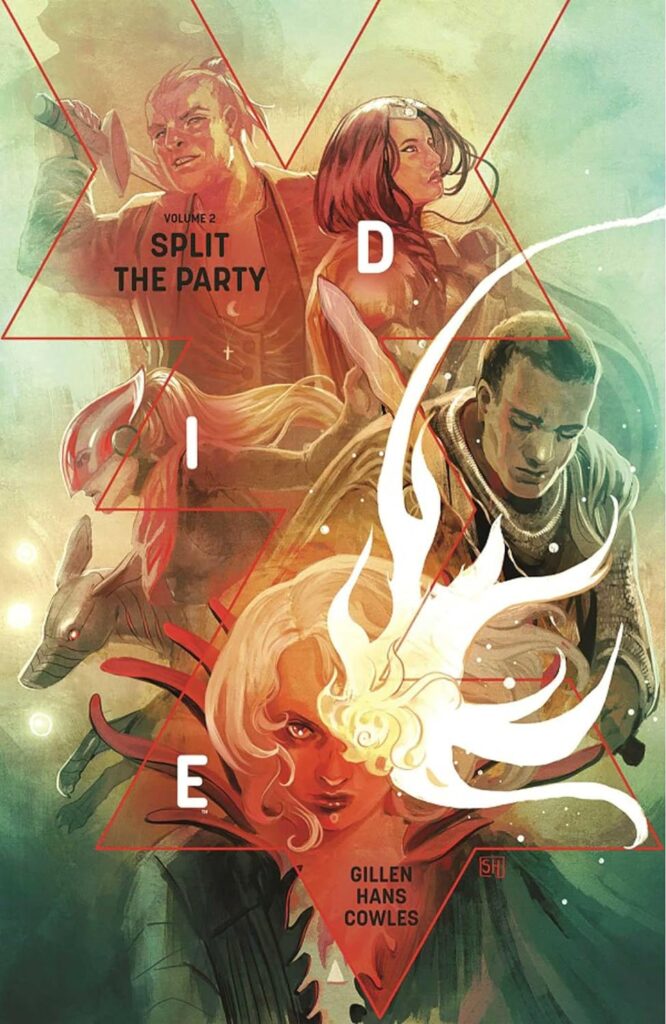
Volume 2: Split the Party
The Party is divided emotionally, ethically, and geographically, spread across the world of Die. Ash and his group make for the realm of Angria, where twenty-five years ago, they had friends and allies. Chuck and Isabelle struggle to protect the survivors of Glass Town, seeking help wherever they can find it, Isabelle striking bargains with any God she can, while Chuck, as the Fool, rushes into battle. But Isabelle is running up too many divine debits, and Chuck learns that he’s dying of a fatal disease.
On the other side of the planet, Ash alienates her friends and the party recombines and then splits further as she struggles to come out on top of Angria’s political games. With her are her former lover, the vampire Zamora, and their son Augustus, who somehow managed to grow up a decent person. Separately, the two teams learn more about the mysterious origins of Die, which seems to involve impossible paradoxes and knots in time, and to have both created and been created by the Brontes, H. G. Wells, and Tolkien, among others.
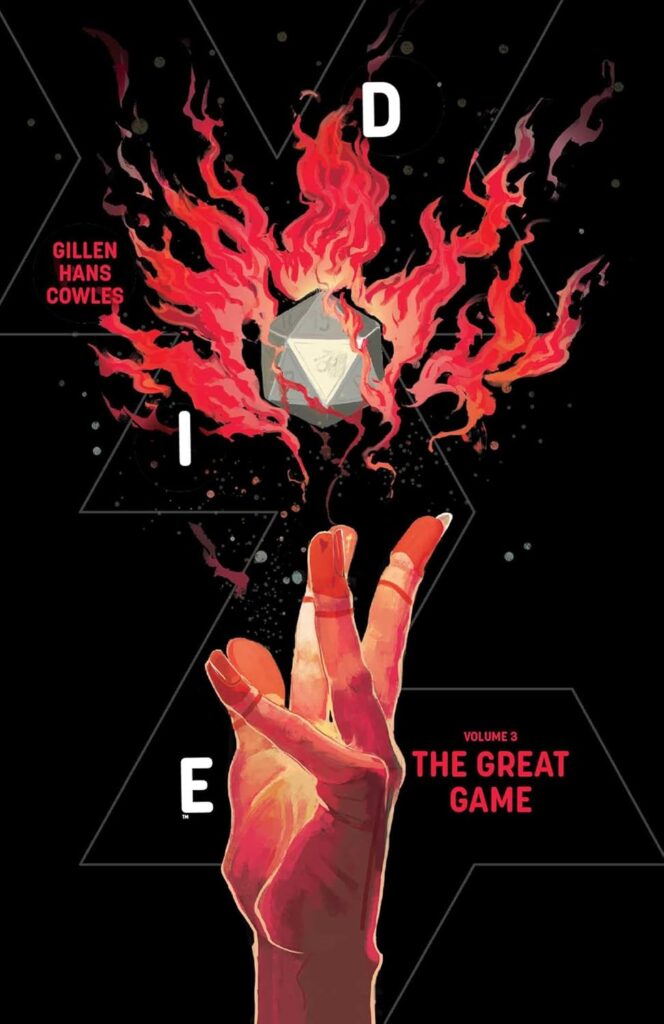
Volume 3: The Great Game
They’ve been in Die for months. Ash rules Angria but the Party’s actions have fractured the delicate stalemate between Die’s powers, and the Masters of the Realms are getting involved. Ash and Isabelle are working together, the undead Sol in tow, while Matt, Chuck, and Angela are at odds with them and trying to find answers of their own. Angela discovers that a time-twisted version of her estranged real-world daughter has become one of the Fallen, while Matt is told by the Gods that his father has died.
They all know that if some of them want to leave, and some of them don’t, the only way around it is to murder one another. They come together in an explosive confrontation that leaves Ash’s plans and manipulations in tatters.
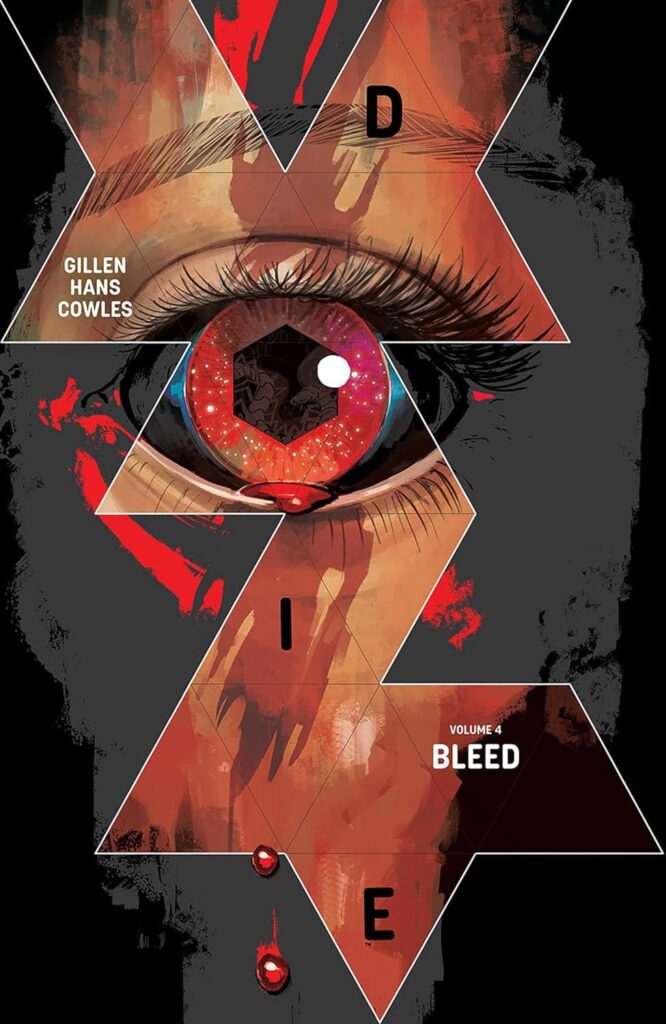
Volume 4: Bleed
Reunited by not reconciled, the Party finally delves into a dungeon, seeking the heart of the world of Die, a final boss they can defeat, and answers to their questions and all the pain they carry with them.
DIE is a dense, layered, thoughtful work. Every aspect is carefully considered. The writing and the art and (unusually for comics) the visual design intersect beautifully. Originally published in (naturally) 20 issues, the four collected volumes expand on and extend the use of motifs and deliberate, conscious engagement with the language, look, and feel of both tabletop role-playing games and their antecedents in fiction, imaginative play and wargaming.
That means that DIE is very, very referential. Creative works that are bursting at the seams with references tend to be either callow and pandering, or celebratory and affirming; the Family Guy vs. Lower Decks divide. DIE celebrates its sources, but also engages with them critically. And not just in superficial ways – H. P. Lovecraft’s influence on multiple genres and his racism are both acknowledged and criticized for instance. But stopping with Lovecraft would have been too obvious and easy. Gillen turns a critical eye on the other inspirations of modern fantasy TTRPGs as well, and on the subsequent decisions by game designers, game masters, and players that flattened those inspirations into often derivative settings that only exist to give characters a place to kick in doors, kill things, and take their stuff.
(Gillen is explicit and savage about this, in a scene early in Fantasy Heartbreaker, where Ash meets the Master of one Realm, a sort of avatar or memory of Tolkien, who’s disgusted by what his stories have been twisted into.)
Gillen walks a difficult line, trying to both praise and bury TTRPGs, and his writing walks that line surprisingly effectively. He achieves that through (partial, and very imperfect) self-awareness on the part of his cast of characters, especially Ash, and by subverting both their and the readers’ expectations.
This subversion carries through in the art as well as in the writing. One way that plays out visually is that, while the characters engage in a great deal of violence, there are very few fight scenes as such. Stephanie Hans’ art depicts the prelude to violence, and the shocking, bloody, horrible consequences, but actual combat is depicted only in flashes, via brief, montage-like tableaux. It’s a fascinating choice that consciously subverts the expectations of both comics and role-playing games, and it emphasizes one of the core themes of DIE: That violence is a choice with consequences, and that life and role-playing games alike are about choices and consequences.
In the essays originally published in individual issues of DIE, and included in the collections, Gillen is very open about his influences – which I think is fitting for a work that makes so much of adults confronting their adolescent fantasies, and recognizing at last the influences that they lacked the knowledge to see, then. Per Gillen, the key influence on DIE, the genesis of it, was the 1980s Dungeons & Dragons cartoon, which is of course a portal fantasy about teenagers from our world being transported into a magical realm based on a table-top roleplaying game, carrying out quests at the behest of the mysterious Dungeon Master, and trying to find a way home.
And yes, those fingerprints are all over DIE, which both deconstructs and in the end reconstructs the fantasy of entering the world of your TTRPG and coming back – the first time wounded and traumatized by the experience, the second time… well, still wounded and traumatized in some ways, but in others healed and stronger for having confronted trauma.
(As an aside, I was absolutely sure that the late Joel Rosenberg’s Guardians of the Flame series, the first volume of which was published in 1983 and which is also a portal fantasy about a group of young people who are forcibly transported to the world of the TTRPG and suffer from horrible trauma as a result, must have been an influence on DIE – but Gillen never mentions it, and being so open about his other influences makes me suspect he wasn’t familiar with Rosenberg’s books.)
DIE‘s conclusion, after grappling with the real personal and cultural hazards of becoming mired in trivial, derivative adolescent power fantasies, is a powerful and affirming one: That despite all their flaws – and our flaws – TTRPGs can be ways for us to explore, learn, grow, heal, and know ourselves better.
Finally, I’d be remiss if I didn’t note that there’s now also a DIE table-top roleplaying game, originally created by Gillen and Hans in the back pages of the comic, and later developed and published more thoroughly after a successful crowdfunding campaign by the game company Rowan, Rook & Decard. I have a copy of that, as well – although like all the other games I acquired during the pandemic, I haven’t had a chance to play it yet.
DIE isn’t just a significant work in comics, I would argue that it’s a significant work of fantasy, one that grapples with the deep genre roots of table-top roleplaying games, and of the ethical implications of immersive fantasy worlds. I recommend it wholeheartedly, and I want my Skiffy & Fanty TTRPG friends like Trish, Paul, Brandon and Shaun to read it so we can talk about it… and maybe play the DIE TTRPG? Please?
Disclosures: I have no personal or professional relationships with the creators or publisher. I purchased my own copies of the graphic novels for review.

